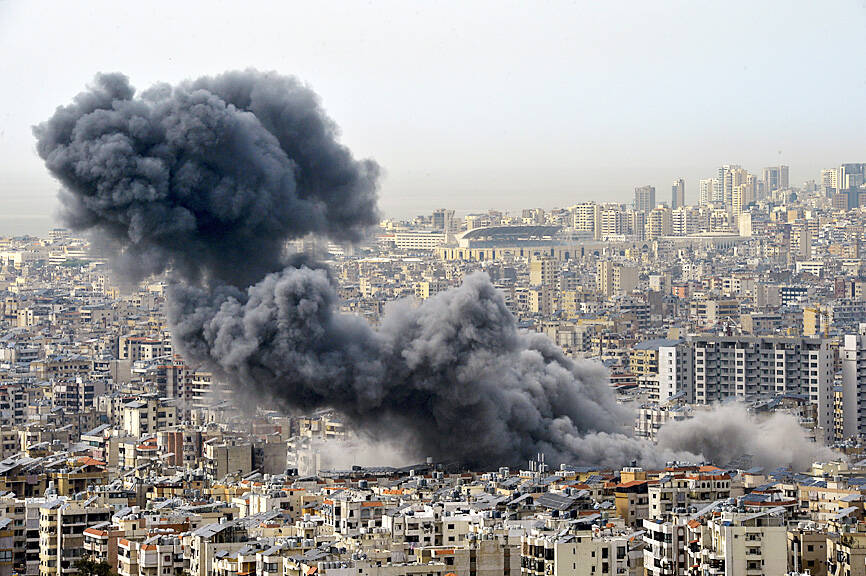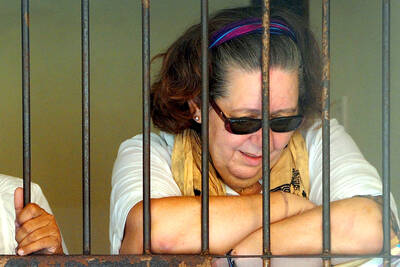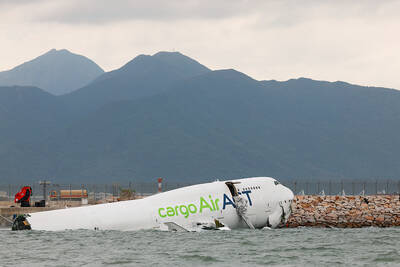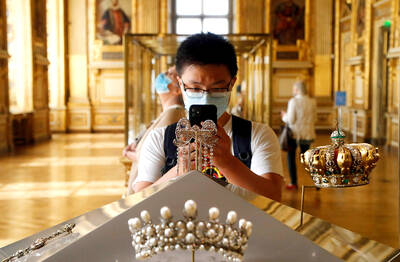Israel on Friday launched an attack on Lebanon’s capital for the first time since a ceasefire ended the latest Israel-Hezbollah war in November last year.
Associated Press reporters in Beirut heard a loud boom and witnessed smoke rising from an area in the city’s southern suburbs that Israel’s military had vowed to strike.
It marked Israel’s first strike on Beirut since a ceasefire took hold in November last year between it and the Hezbollah militant group, although Israel has attacked targets in southern Lebanon almost daily since then.

Photo: EPA-EFE
Israel’s army said it hit a Hezbollah drone storage facility in Dahiyeh, which it called a militant stronghold.
The strike came after Israel, which accuses Hezbollah of using civilians as human shields, warned residents to evacuate the area.
The area struck is a residential and commercial area, and is close to at least two schools.
Israel sends a message to the Lebanese government
The attack was retaliation for rockets it said were fired from Lebanon into northern Israel, Israeli officials said.
They promised strikes on Beirut would continue unless Lebanon’s government worked to ensure such attacks ceased.
“We will not allow firing at our communities, not even a trickle,” Israeli Prime Minister Benjamin Netanyahu said. “We will attack everywhere in Lebanon, against any threat to the State of Israel.”
Hezbollah denied firing the rockets and accused Israel of seeking a pretext to continue attacking Lebanon.
Lebanon’s government ordered all schools and universities in Beirut’s southern suburb of Hadath to close for the day.
Residents were seen fleeing the area in cars and on foot ahead of the strike.
Israel’s military yesterday admitted that it had fired on ambulances in the Gaza Strip after identifying them as “suspicious vehicles,” with Hamas condemning it as a “war crime” that killed at least one person.
The incident took place on Sunday last week in the Tal al-Sultan neighbourhood in the southern city of Rafah, close to the Egyptian border.
Israeli troops launched an offensive there on Thursday last week, two days after the army resumed aerial bombardments of Gaza following an almost two-month-long truce.
Israeli troops had “opened fire toward Hamas vehicles and eliminated several Hamas terrorists,” the Israeli military said in a statement.
“A few minutes afterward, additional vehicles advanced suspiciously toward the troops... The troops responded by firing toward the suspicious vehicles, eliminating a number of Hamas and Islamic jihad terrorists.”
The military did not say if there was fire coming from the vehicles.
It added that “after an initial inquiry, it was determined that some of the suspicious vehicles ... were ambulances and fire trucks,” and condemned “the repeated use” by “terrorist organizations in the Gaza Strip of ambulances for terrorist purposes.”
The day after the incident, Gaza’s civil defense agency in a statement said that it had not heard from a team of six rescuers from Tal al-Sulta who had been urgently dispatched to respond to deaths and injuries.
On Friday, it reported finding the body of the team leader and the rescue vehicles — an ambulance and a firefighting vehicle — and said a vehicle from the Palestine Red Crescent Society was also “reduced to a pile of scrap metal.”
Basem Naim, a member of Hamas’ political bureau, accused Israel of carrying out “a deliberate and brutal massacre against civil defense and Palestinian Red Crescent teams in the city of Rafah.”
“The targeted killing of rescue workers — who are protected under international humanitarian law — constitutes a flagrant violation of the Geneva Conventions and a war crime,” he said.
Since March 18, “Israeli airstrikes in densely populated areas have killed hundreds of children and other civilians,” UN Humanitarian Affairs and Emergency Relief Coordinator undersecretary-general Tom Fletcher said.
“Patients killed in their hospital beds. Ambulances shot at. First responders killed,” he said in a statement. “If the basic principles of humanitarian law still count, the international community must act while it can to uphold them.”

Indonesia was to sign an agreement to repatriate two British nationals, including a grandmother languishing on death row for drug-related crimes, an Indonesian government source said yesterday. “The practical arrangement will be signed today. The transfer will be done immediately after the technical side of the transfer is agreed,” the source said, identifying Lindsay Sandiford and 35-year-old Shahab Shahabadi as the people being transferred. Sandiford, a grandmother, was sentenced to death on the island of Bali in 2013 after she was convicted of trafficking drugs. Customs officers found cocaine worth an estimated US$2.14 million hidden in a false bottom in Sandiford’s suitcase when

CAUSE UNKNOWN: Weather and runway conditions were suitable for flight operations at the time of the accident, and no distress signal was sent, authorities said A cargo aircraft skidded off the runway into the sea at Hong Kong International Airport early yesterday, killing two ground crew in a patrol car, in one of the worst accidents in the airport’s 27-year history. The incident occurred at about 3:50am, when the plane is suspected to have lost control upon landing, veering off the runway and crashing through a fence, the Airport Authority Hong Kong said. The jet hit a security patrol car on the perimeter road outside the runway zone, which then fell into the water, it said in a statement. The four crew members on the plane, which

Japan’s ruling Liberal Democratic Party (LDP) and its junior partner yesterday signed a coalition deal, paving the way for Sanae Takaichi to become the nation’s first female prime minister. The 11th-hour agreement with the Japan Innovation Party (JIP) came just a day before the lower house was due to vote on Takaichi’s appointment as the fifth prime minister in as many years. If she wins, she will take office the same day. “I’m very much looking forward to working with you on efforts to make Japan’s economy stronger, and to reshape Japan as a country that can be responsible for future generations,”

SEVEN-MINUTE HEIST: The masked thieves stole nine pieces of 19th-century jewelry, including a crown, which they dropped and damaged as they made their escape The hunt was on yesterday for the band of thieves who stole eight priceless royal pieces of jewelry from the Louvre Museum in the heart of Paris in broad daylight. Officials said a team of 60 investigators was working on the theory that the raid was planned and executed by an organized crime group. The heist reignited a row over a lack of security in France’s museums, with French Minister of Justice yesterday admitting to security flaws in protecting the Louvre. “What is certain is that we have failed, since people were able to park a furniture hoist in the middle of